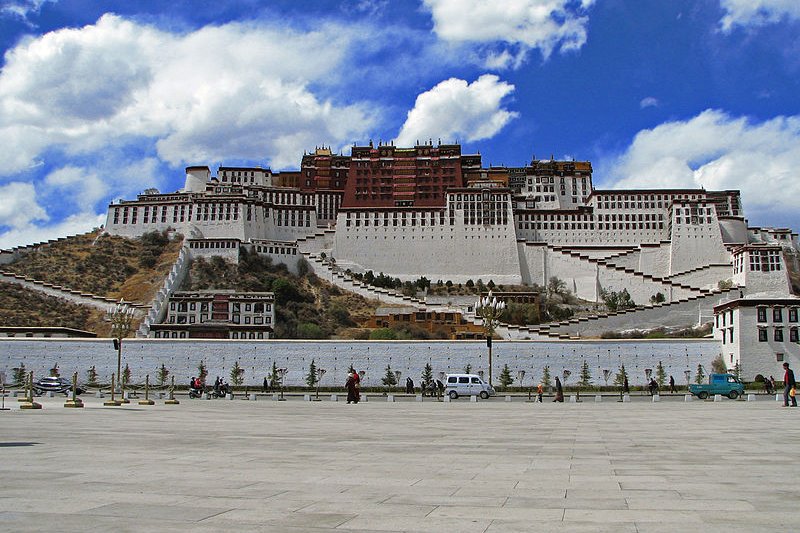 Potala Palace, Tibet
Potala Palace, TibetSource: https://commons.wikimedia.org/wiki/File:Tibet_06_-_005_-_Potala_Palace_(147403406).jpg
Author: McKay Savage

The Potala Palace is the monumental residence of the Dalai Lama, spiritual leader of the Tibetan Buddhist. It is named after Mount Potala, believed by Tibetan Buddhists to be the abode of Chenresig, the Tibetan name for the Avalokitesvara.
Avalokitesvara is the bodhisattva that embodies the compassion of all Buddhas. He is referred to as Padmapani, or "Holder of the Lotus". Among the Chinese, the Avalokitesvara is often depicted in female form, and is known (although scholars are still deliberating over this) as the Guan Yin or Kuan Yin, the goddess of mercy. Among the Tibetans, the Avalokitesvara is believed to be incarnated in the Dalai Lama.
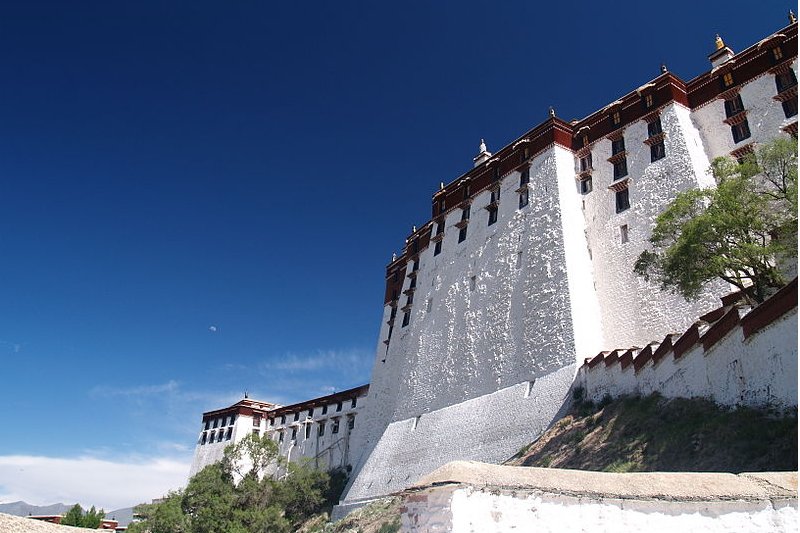 Potala Palace, Tibet
Potala Palace, Tibet
Author: McKay Savage

The Potala Palace is the monumental residence of the Dalai Lama, spiritual leader of the Tibetan Buddhist. It is named after Mount Potala, believed by Tibetan Buddhists to be the abode of Chenresig, the Tibetan name for the Avalokitesvara.
Avalokitesvara is the bodhisattva that embodies the compassion of all Buddhas. He is referred to as Padmapani, or "Holder of the Lotus". Among the Chinese, the Avalokitesvara is often depicted in female form, and is known (although scholars are still deliberating over this) as the Guan Yin or Kuan Yin, the goddess of mercy. Among the Tibetans, the Avalokitesvara is believed to be incarnated in the Dalai Lama.
 Potala Palace, Tibet
Potala Palace, TibetSource: https://commons.wikimedia.org/wiki/File:The_Potala_Palace.jpg
Author: Steve Hicks

The Potala Palace measures 400 meters from east to west, and 350 meters from north to south. It is held in position by stone walls which are 3 meters thick on average, and 5 meters thick at the base. The complex is sixteen storeys tall, containing over 1000 rooms, 10,000 shrines and about 200,000 statues. It rises 1000 feet from the valley floor.
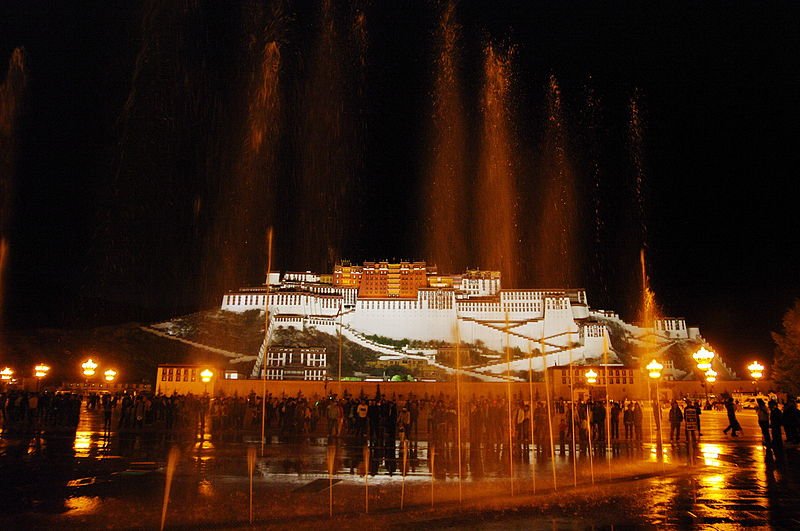 Potala Palace at night
Potala Palace at night
Author: Steve Hicks

The Potala Palace measures 400 meters from east to west, and 350 meters from north to south. It is held in position by stone walls which are 3 meters thick on average, and 5 meters thick at the base. The complex is sixteen storeys tall, containing over 1000 rooms, 10,000 shrines and about 200,000 statues. It rises 1000 feet from the valley floor.
Brief History of Potala Palace
The site of the Potala Palace was originally a meditation retreat of King Songtsen Gampo, who built his first palace there in 637. The present Potala Palace was constructed in 1645 by the Great Fifth Dalai Lama, Lozang Gyatso, after one of his spiritual advisers, Konchog Chophel pointed out to him that the site is ideal as a seat of government. The Dalai Lama moved into the Potrang Karpo, or White Palace, in 1649, although construction continued until 1694, twelve years after his death. Between 1690 and 1694, the Potrang Marpo, or Red Palace, was added to the complex. Potala Palace at night
Potala Palace at nightSource: https://commons.wikimedia.org/wiki/File:TIB-lhasa-potala-2.jpg
Author: Bgabel

The Potala Palace suffered some damage during the Tibetan uprising in 1959, although it escaped being demolished during the Cultural Revolution of 1966 through the personal intervention of Zhou Enlai, premier of the People's Republic. Nevertheless, almost all the 100,000 pieces of Tibetan scriptures and manuscripts were destroyed or damaged or stolen.
The Potala Palace was inscribed as a World Heritage Site in 1994 under "Historic Ensemble of the Potala Palace, Lhasa". In 2000 and 2001, Jokhang Temple and Norbulingka were added as extension to the site. To preserve the palace, visitorship is limited to 1600 a day, and opening hours reduced to six hours per day. With the opening of the Qingzang railway to Lhasa, visitorship quota was increased to 2300 a day, a number that is easily reached by mid morning. In the months of July and September, opening hours are extending, allowing up to 6000 visitors per day.
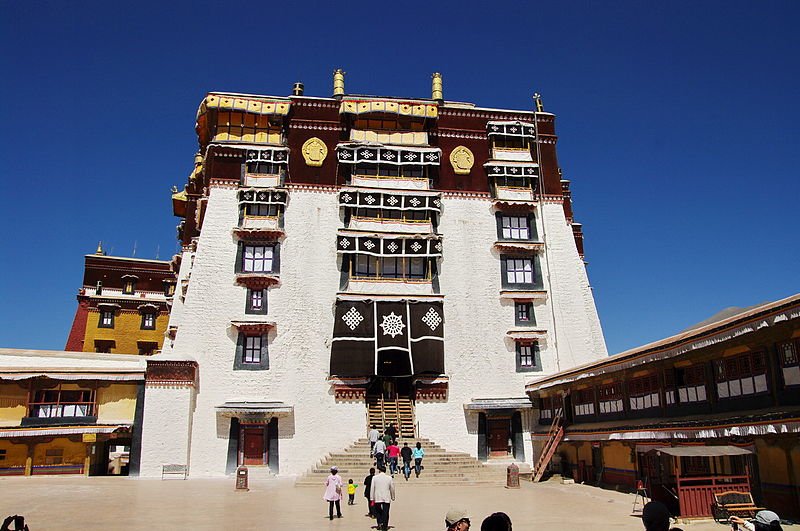 Potrang Karpo, the White Palace of the Potala Palace
Potrang Karpo, the White Palace of the Potala Palace
Author: Bgabel

The Potala Palace suffered some damage during the Tibetan uprising in 1959, although it escaped being demolished during the Cultural Revolution of 1966 through the personal intervention of Zhou Enlai, premier of the People's Republic. Nevertheless, almost all the 100,000 pieces of Tibetan scriptures and manuscripts were destroyed or damaged or stolen.
The Potala Palace was inscribed as a World Heritage Site in 1994 under "Historic Ensemble of the Potala Palace, Lhasa". In 2000 and 2001, Jokhang Temple and Norbulingka were added as extension to the site. To preserve the palace, visitorship is limited to 1600 a day, and opening hours reduced to six hours per day. With the opening of the Qingzang railway to Lhasa, visitorship quota was increased to 2300 a day, a number that is easily reached by mid morning. In the months of July and September, opening hours are extending, allowing up to 6000 visitors per day.
 Potrang Karpo, the White Palace of the Potala Palace
Potrang Karpo, the White Palace of the Potala PalaceSource: https://commons.wikimedia.org/wiki/File:TIB-lhasa-potala-weisser-palast.jpg
Author: Bgabel

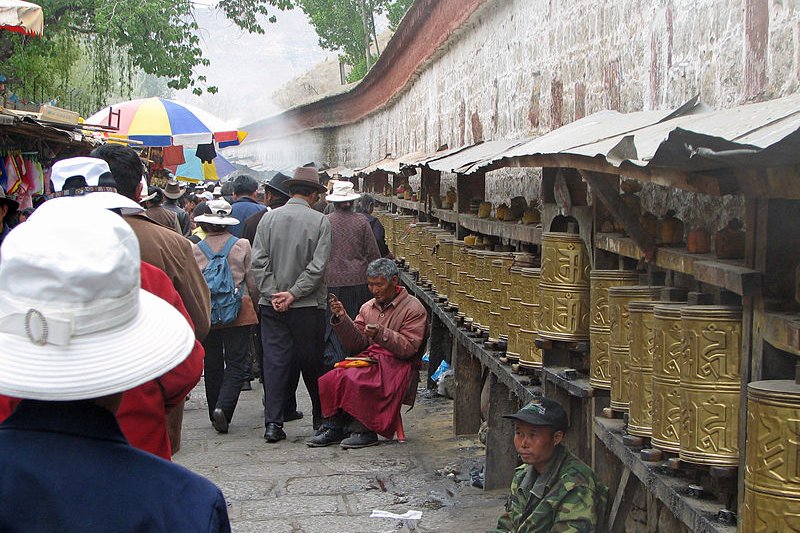 Circumambulating the Potala Palace
Circumambulating the Potala Palace
Author: Bgabel

Tourist Sights in Potala Palace
The following are the different sights within the Potala Palace complex.- Potrang Karpo (White Palace)
The Potrang Karpo is the living quarters of the Dalai Lama. Though first built in the 17th century, it reaches its present size through the expansion carried out during the reign of the 13th Dalai Lama in the early 20th century. A central courtyard painted yellow, called Deyangshar, separates the White Palace from the Red Palace. - Potrang Marpo (Red Palace)
The Red Palace is devoted to religious studies and Buddhist prayer. It comprises halls, chapels and libraries on many levels interconnected by galleries and winding passageways. Among the sites within the Red Palace are:- The Great West Hall - main central hall of the Red Palace
- Tomb of the 13th Dalai Lama - west of the Great West Hall. The tomb is in the form of a giant stupa containing jewels and one ton of solid gold.
- Saint's Chapel - the holiest shrine of the Potala Palace
- North Chapel - hall with the images of a crowned Sakyamuni Buddha and the Fifth Dalai Lama
- South Chapel - hall with the image of Padmasambhava, an 8th century Indian saint, with his consort Yeshe Tsogyal.
- East Chapel - hall dedicated to Tsong Khapa
- West Chapel - hall with five golden stupas
- First Gallery - above the West Chapel, with large windows and between them, murals depicting the construction of the palace
- Second Gallery - place for visitors to get refreshments and buy souvenirs
- Third Gallery - passage with murals leading to more rooms containing bronze statues and miniature figurines in copper and gold.
- The Great West Hall - main central hall of the Red Palace
 Circumambulating the Potala Palace
Circumambulating the Potala PalaceSource: https://commons.wikimedia.org/wiki/File:Tibet_06_-_006_-_Potala_Palace_Kora_(147404936).jpg
Author: McKay Savage

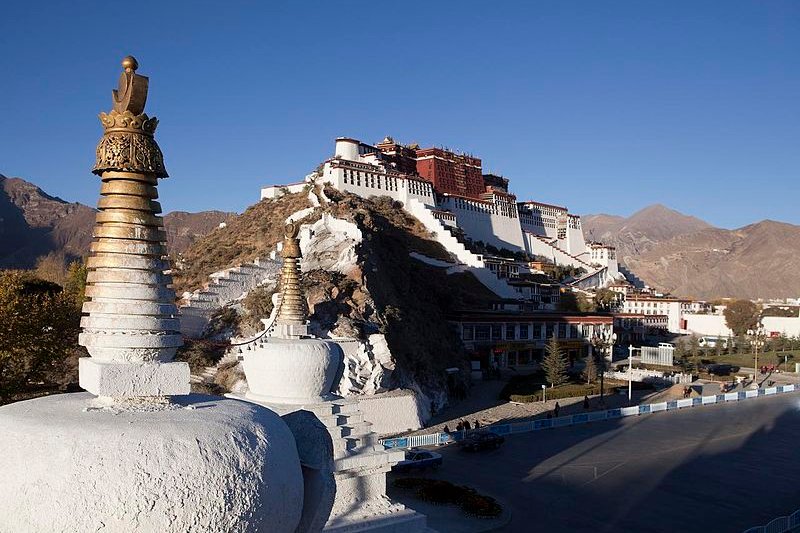 View of Tibetan stupas and the Potala Palace
View of Tibetan stupas and the Potala Palace
Author: McKay Savage

Getting there
Non-Chinese nationals need a special permit to visit Tibet. It is easier to get a group permit (of at least 5 persons) than to obtain individual permits. These can be arranged via a travel agent in Kathmandu. The airport (Lhasa Gonggar Airport) is about an hour from the city.Climate of Lhasa, Tibet
Warmest months in Lhasa are June to August, when the temperature reaches an average of 15°C. Temperature may drop below zero from December to February. View of Tibetan stupas and the Potala Palace
View of Tibetan stupas and the Potala PalaceSource: https://commons.wikimedia.org/wiki/File:Tibet_(5123128003).jpg
Author: Christopher Michel

Looking for information on Penang? Use this Map of Roads in Penang to zoom in on information about Penang, brought to you road by road.

Author: Christopher Michel

List of World Heritage Sites in China
 Latest updates on Penang Travel Tips
Latest updates on Penang Travel Tips
 Map of Roads in Penang
Map of Roads in Penang
Looking for information on Penang? Use this Map of Roads in Penang to zoom in on information about Penang, brought to you road by road.
Copyright © 2003-2025 Timothy Tye. All Rights Reserved.

 Go Back
Go Back